Your container is our priority and rest assured, we’ll ensure that it’s safe from delays, detention, and demurrage. In this blog, we’ll provide you with the perfect and easiest guide to get through container clearance.
In this blog, you’ll learn:
- Container – or customs – clearance can consume time when you’re shipping cargo. Not staying on top of your documents can lead to demurrage and detention too.
- There are several crucial documents that you need for container clearance, some of which are imposed by different governments.
- Shipper-owned containers (SOCs) might be the best option for smooth container clearance and to save both time and money.
- Container xChange gives you the utmost transparency and flexibility across 2,500+ locations and 1,000+ companies through its commission-free platform.
Stay with us as we give you a detailed lowdown of what you need and where to get it. But if you already have your paperwork sorted, let’s find you some containers to trade or lease next.
Want to see the container availability on your route? Use our public search option below to find containers. All you have to do is enter your pick-up and drop-off locations and press the search button. Give it a go now!
What is container clearance?
Didn’t we all imagine lesser logistical nightmares after Covid-19? But then came Omicron, the Russia-Ukraine war, and now the lockdown in China! Did you see the unbelievable maritime congestion at the Shanghai port in April? No two days have been alike in the shipping industry. We know it’s overwhelming. But we’re here with good news. Your container is our priority and rest assured, we’ll ensure that it’s safe from delays, demurrage, and detention.

But how will we do that? Well, let’s say you’re exporting (or importing) 500 luxury handbags from Shanghai, China, to La Spezia, Italy. When you load the bags onto a container, you need to clear the container through the customs authorities at both the ports. This is a part of the customs clearance process and is often known as ‘container clearance’.
Why is container clearance needed?
Waiting for customs authorities to check your paperwork and cargo consumes a lot of time. In the shipping industry, time is money. And you can save them both by preparing for a seamless container clearance. Let’s understand this through an example.
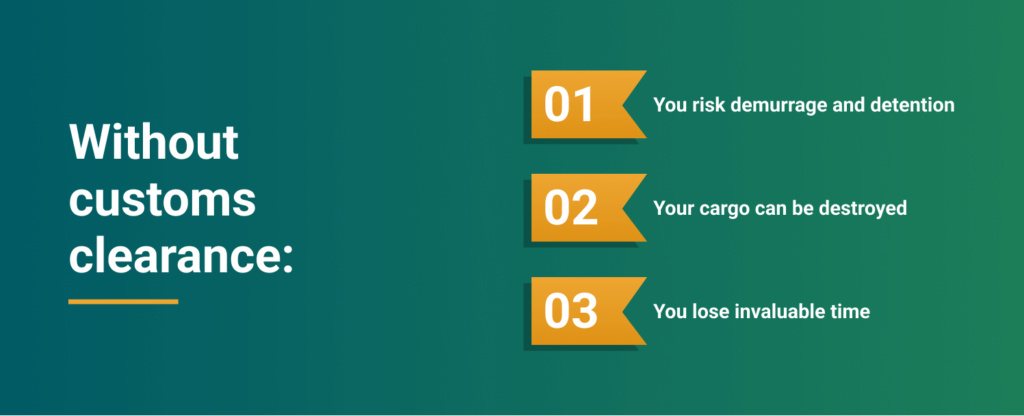
For example, you’re using a carrier-owned container (COC) to ship your cargo and it got stuck with customs. The delays caused by the holdup will have you pay hefty demurrage and detention charges to the carrier. Over time, these charges can add up to become a huge amount of money.
So, what’s a certain, quick and safe way to get your bags to Italy then? Well, by knowing how container clearance works and staying on top of all the documents. Let’s make this even easier for you now.
Types of container clearance documents
Having the right documents at the right time and place ensures swift international freight shipping. Here, we’ve prepared a detailed list of the essential documents for you.
Commercial invoice
A commercial invoice is an export document that you show to the customs officials. They need it to verify which taxes and import duties are applicable to your cargo. It’s advisable that you write the details of the shipment with the company letterhead.
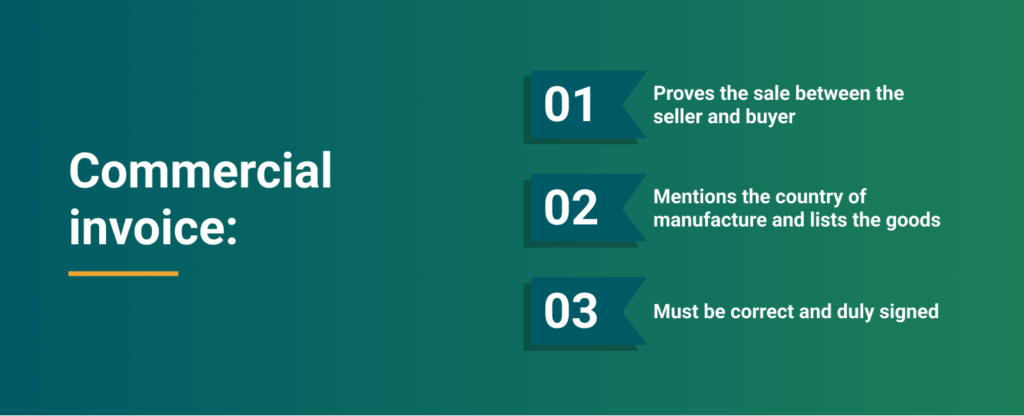
Mention yours as well as the receiver’s company details, addresses, contact numbers, and tax numbers. Describe the goods you’re exporting, including their quantity and value. Also, mention the shipment number. This document proves the sale of goods between two parties. So, get all the details correct here.
Watch this video to know more about commercial invoice and how to fill it.
Certificate of origin
The certificate of origin, also known as CO, establishes where the goods of the shipment were wholly obtained, produced, and manufactured. Not just customs, even banks and private stakeholders use this document. But customs authorities use it to determine the duty on the goods. Many times, it’s also used to check if the shipment is even legal to export/import.
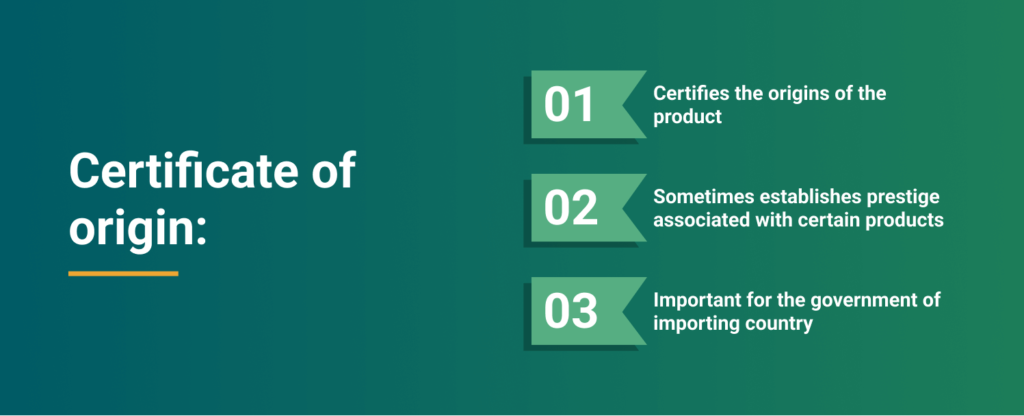
For instance, in December 2021, US President Joe Biden signed the Uyghur Forced Labor Prevention Act (UFLPA). All goods manufactured in China’s Xinjiang Uyghur Autonomous Region (XUAR) are allegedly products of forced labor. And so, with the UFLPA coming into action, products from XUAR are not allowed entry at U.S. ports.
Remember the example of luxury bags you’re shipping from Shanghai, which we mentioned earlier in this blog? You show authorities the CO to prove that your bags were not manufactured in XUAR, even partially.
Bill of lading
The bill of lading is another important, legal document. It serves as a receipt for freight services. It’s also a contract between a carrier, shipper, and consigneeWhat is a consignee? When transporting freight (by ocean, air, or land), there are two parties involved — one who is shipping and the other who is receiving the freight. The recipient of the goods b... More. This bill clarifies the details of a shipment: what the goods are, where they’re going and where they’re coming from. The bill of lading is only issued after the vessel has departed from the port of loading and the customer has provided all the important details about the shipment. It includes cargo description, weight, details about the parties involved, etc.
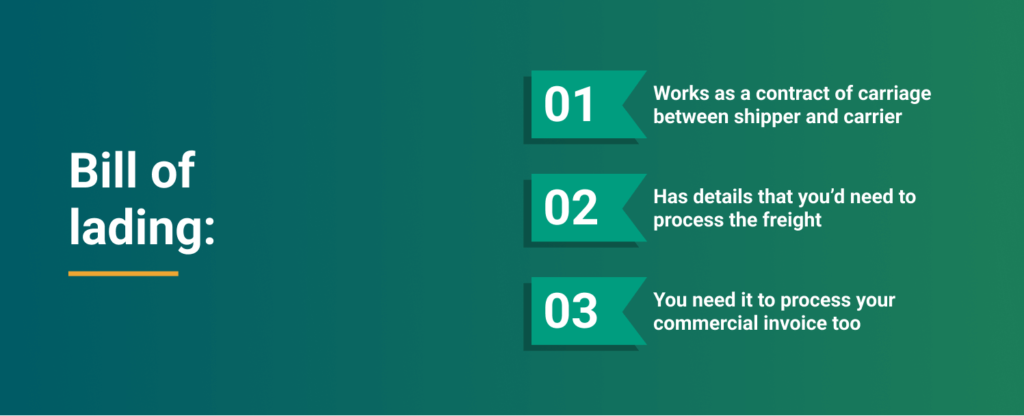
Buyer’s purchase order
A buyer’s purchase order (PO) is an official document issued by a buyer. Let’s go back to the luxury bags you’re forwarding, for example. The buyer of the bags has promised the seller to pay for them. But as you’ve still not reached the destination port with the bags, the buyer hasn’t yet paid the seller. So, they use the PO as a commitment to pay the seller for the sale of specific products or services.
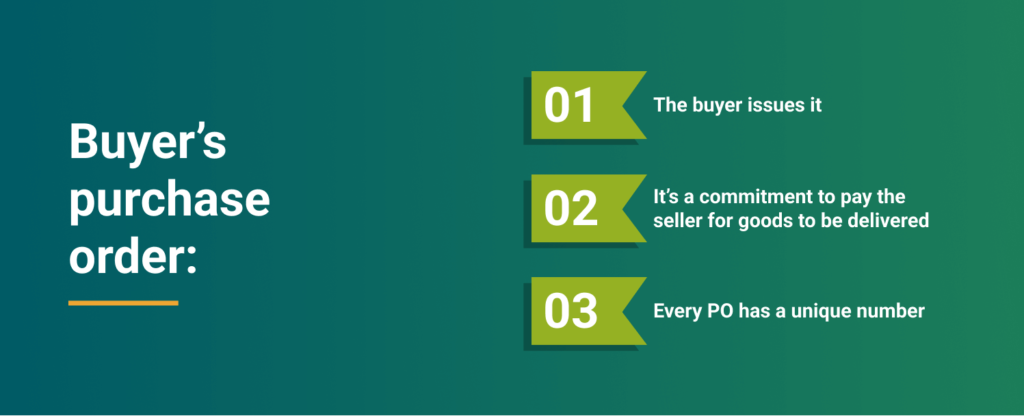
In this case, it’s the bags, even though you’ll deliver them only in the future. While it helps the buyer to place an order and not pay immediately, for the seller, it serves as credit without risk. A PO has a unique number, which means, it’s easy to track delivery and payment.
Packing list
A packing list is another crucial document for export. You, your freight forwarding company, your packers, and other involved parties use it to keep track of the cargo. It carries an itemized list of everything in your shipment.
You can use it to check the dimensions, sizes, weights, etc of the cargo. You need to provide a detailed export packing list when you export goods. Given how detailed this document is, you wouldn’t need to unwrap your shipment after it’s put in cases. That streamlines your process.
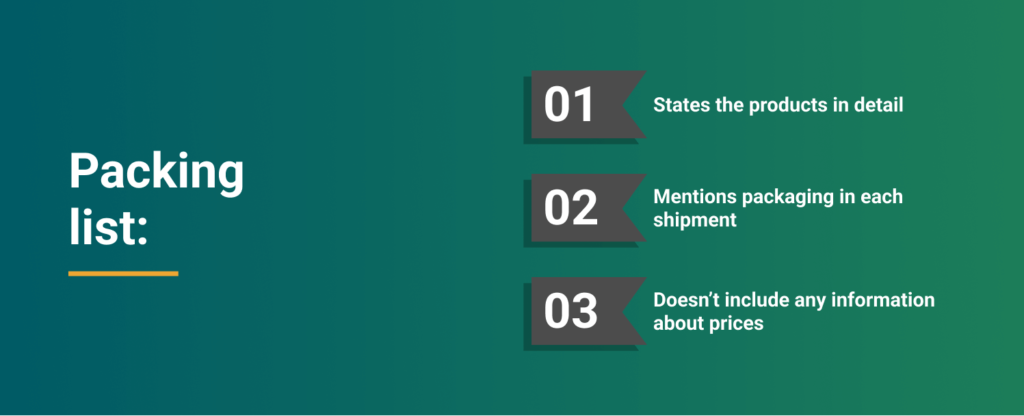
Shipping bill
If you’re exporting cargo, this is one of your first steps to take. You’ll need to fill out a shipping bill and you’re allowed to load cargo in your containers. And if you’re a shipping agent yourself, it will be your responsibility to issue this document as well. You do so for the buyer, seller, freight forwarder, and so on. Essentially, this bill allows customs authorities to clear the shipments.
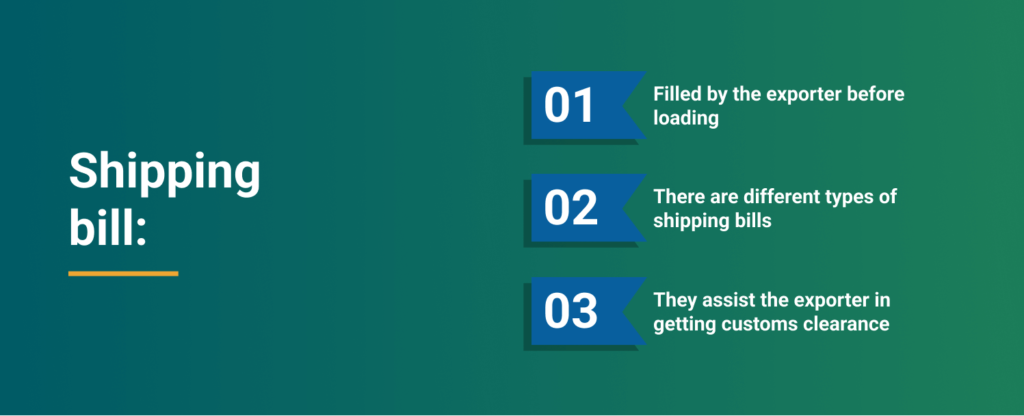
The shipping bill must be filled out as an application. How the bill is formed depends on what you’re shipping. You distinguish between, for instance, dutiable goods, duty-free goods, and goods with drawback claims.
Export license
What are you exporting? To whom and where? And how will the product be used? Depending on the answers, you might need an export license. For example, cargo exported from the US doesn’t require an export license. Essentially, an export license is a government document. It proves the approval to export a specific number of goods to specified countries. But do note that there are some goods that are subject to special surveillance by the authorities. In such cases, you can export those goods only if you hold the export license for them.
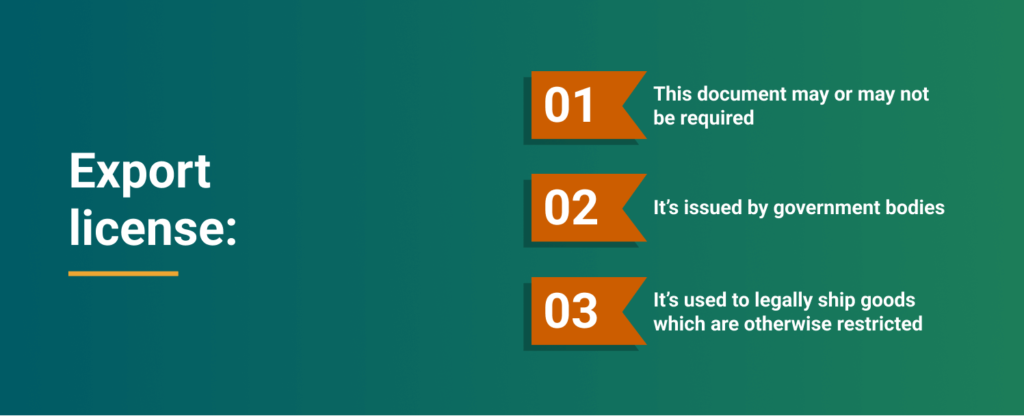
Bill of entry
The importer is often the one who prepares the bill of entry. This bill documents in detail the cargo that enters the customs house. These details include the amount, type, place of origin, or destination. Customs officials issue it. It also explains what duties you’re paying, accordingly.
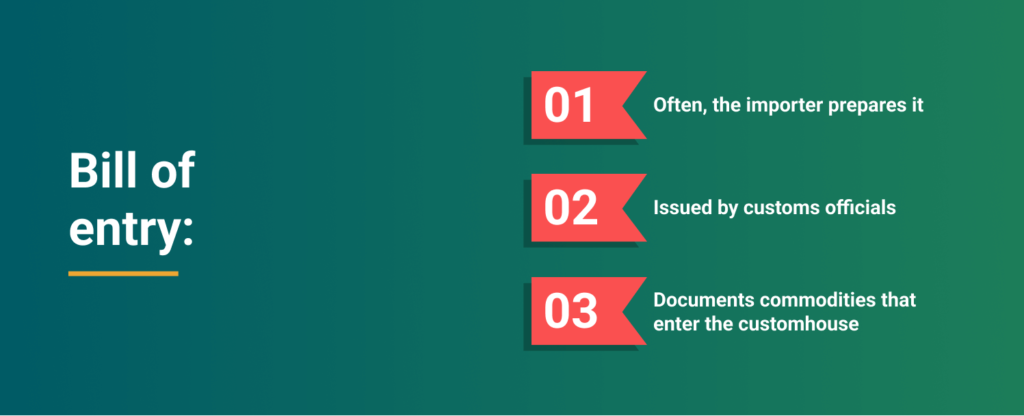
We’ve discussed container clearance documents in detail by now. But what’s next? Well, let’s save you your valuable time and hard-earned money next!
Digitize your documents with Container xChange
Go digital. Maintaining paperwork, especially hard copies of shipping documentsWhat are shipping documents? In shipping, shipping documents are documents that provide information about the goods being shipped. They may include information such as the origin and destination of th... More, is overwhelming. Worse, if you lose them, it can result in major tax penalties. Above all, you cannot clear your container without them. One extremely effective way to solve this problem is to use only digital documents.
At Container xChange, we’re happy to offer you flexible, cost-saving options to do so. Digitizing your documents saves you time and makes you efficient. It also helps you with more environmentally friendly, sustainable methods of doing business.
xChange gives you a range of simplified digital solutions, reduced costs, and enhanced customer experience. We can also offer you payment infrastructure and efficient operating systems.
Still not sure? No worries. We would suggest that you book a quick demo and then decide your course. To do so, please click on the banner below.
Avoid demurrage and detention
We don’t want to discourage you. Yet you must know that demurrage and detention charges can be higher than even the price of the container! For those who aren’t sure what they are, every container needs to be delivered back within a set number of days called free days. Demurrage and detention charges apply when you don’t return a container to the carrier or shipping line within the free days. If that happens, you’ll need to pay daily charges and over time, they become huge amounts.
Digitizing your documents helps you avoid these dreadful demurrage and detention charges to a great extent. But there’s another way as well.
How SOCs help in container clearance
Another way of avoiding the risk of demurrage and detention charges is by using shipper-owned containers (SOCs). When you’re using SOC containers, you’re under no obligation to pay these charges to the carrier. Plus, you have more control over your shipping process.
On our commission-free platform, xChange, we involve a competent network of partners to ensure that you can ship containers with ease. You can buy, sell, and lease SOC containers from 1,000+ companies worldwide.
In fact, we also help you with detailed track and trace reports. We notify you if there’s a container event, from a changed ETAWhat is estimated time of arrival? Estimated time of arrival, commonly known as ETA, is a frequently used term globally to denote the time of coming. In the shipping & logistics industry, it is ... More to a container traveling in the wrong direction. The flexibility we offer is also why we have 10,000 transactions per month. If you want to find out more about our tracking API, check out this blog post all about the topic.
No need for lengthy email correspondence or stressful negotiations. We’re only one click away.
Embassies and help desks for container clearance
But while we’re always ready to help you, please bear in mind that different countries have different rules and regulations. And sometimes there are differences within one country from harbor to harbor. These differences can, for example, be that a country’s import regulations require specific documentation for its financial institutions. When looking for such information, a good place to start from can also be embassy websites. They often have information available on national and regional regulations.
The EU also has a trade helpdesk page dedicated to helping traders have their customer clearance documents in order. Apart from that, we’re in a port city and work close to the container terminal at Hamburg, Germany. This gives us the advantage of working closely with the ships and port handling companies. As you already know, our online container marketplace is a commission-free platform. So, every company on our platform is equally relevant for us. When you look for containers on our platform, you’ll find them across 2,500+ locations and in very good prices. Not only that, we also manage and protect your payments. Why? Because we hear you and strive to make business simpler for you every day. If you click on the banner below, it will lead you to our experts who are waiting to help you 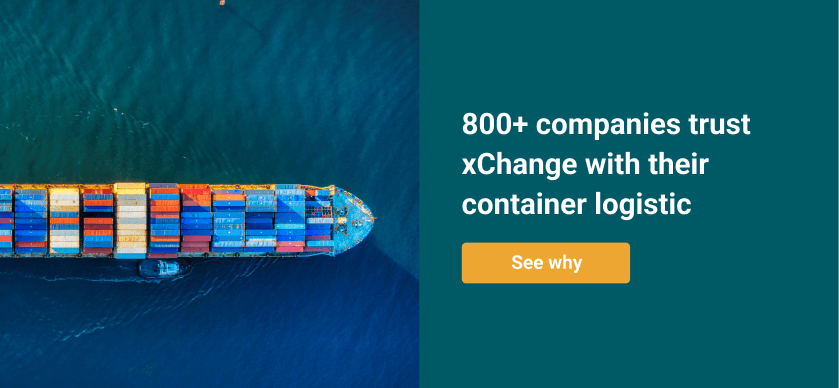
What’s container clearance?
Container clearance is the customs clearance process while shipping goods. These goods are loaded as one full container or as part of a full container. They need to be cleared through customs at the port.
How long does it take a container to clear customs?
A container takes less than 24 hours to clear through customs. However, at certain it can also take several days or weeks for goods to be inspected.
What are clearance documents?
Clearance documents are ccommercial documents that are needed for customs clearance. They include bill of lading, country of origin certificate, shipping bill, export license, and so on.
Who pays customs duty?
The receiver generally pays customs fees and import taxes, instead of the shipper.




